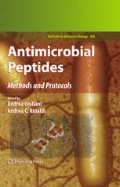Abstract
Over the past decade, the emergence of bacterial strains resistant to conventional antibiotics has necessitated the discovery and development of new antimicrobial therapies. This chapter describes a skin infection model that is based on the use of excised skin derived from the domestic pig. The model conditions mimic the environment of human skin and efficiently support the growth of clinically relevant bacterial and fungal species, thus making it useful for evaluating the activity of antimicrobial peptides and other antibiotics as well as their respective formulations.
Access this chapter
Tax calculation will be finalised at checkout
Purchases are for personal use only
References
Ray, T.L. (1985) Animal models of experimental Candida infection of the skin. In Models in Dermatology. Maibach, H.I., Lowe, N.J. (Eds.), Vol. 1, pp. 41–50. Basel: S. Karger AG.
Jordan, W.E. (1970) The experimental induction of superficial cutaneous infections in guinea pigs J. Invest. Derm. 55, 149–152.
Sedlock, D.M. (1985) Animal skin degerming models. In Models in Dermatology. Maibach, H.I., Lowe, N.J. (Eds.), Vol. 2, pp. 131–144. Basel: S. Karger AG.
Meyer, W., Schwarz, R., and Neurand, K. (1978) The skin of domestic mammals as a model for the human skin, with special reference to the domestic pig Curr. Probl. Dermatol. 7, 39–52.
Boon, R. J., Beale, A. S., and Sutherland R. (1985) Efficacy of topical mupirocin against an experimental Staphylococcus aureus surgical wound infection. J. Antimicrob. Chemother. 16, 519–526.
Friedland, H.D., Sharp, D.D., and Robinson, J.R. (2003) Double-blind, randomized, vehicle-controlled study to assess the safety and efficacy of MBI 594AN in the treatment of acne vulgaris. Abstr. 61st Ann. Meeting Am. Acad. Derm. 61, 22.
Isaacson R. E. (2003) MBI-226 Micrologix/Fujisawa Curr. Opin. Invest. Drugs 4, 999–1003.
Author information
Authors and Affiliations
Editor information
Editors and Affiliations
Rights and permissions
Copyright information
© 2010 Springer Science+Business Media, LLC
About this protocol
Cite this protocol
Rubinchik, E., Pasetka, C. (2010). Ex Vivo Skin Infection Model. In: Giuliani, A., Rinaldi, A. (eds) Antimicrobial Peptides. Methods in Molecular Biology, vol 618. Humana Press, Totowa, NJ. https://doi.org/10.1007/978-1-60761-594-1_22
Download citation
DOI: https://doi.org/10.1007/978-1-60761-594-1_22
Published:
Publisher Name: Humana Press, Totowa, NJ
Print ISBN: 978-1-60761-593-4
Online ISBN: 978-1-60761-594-1
eBook Packages: Springer Protocols

